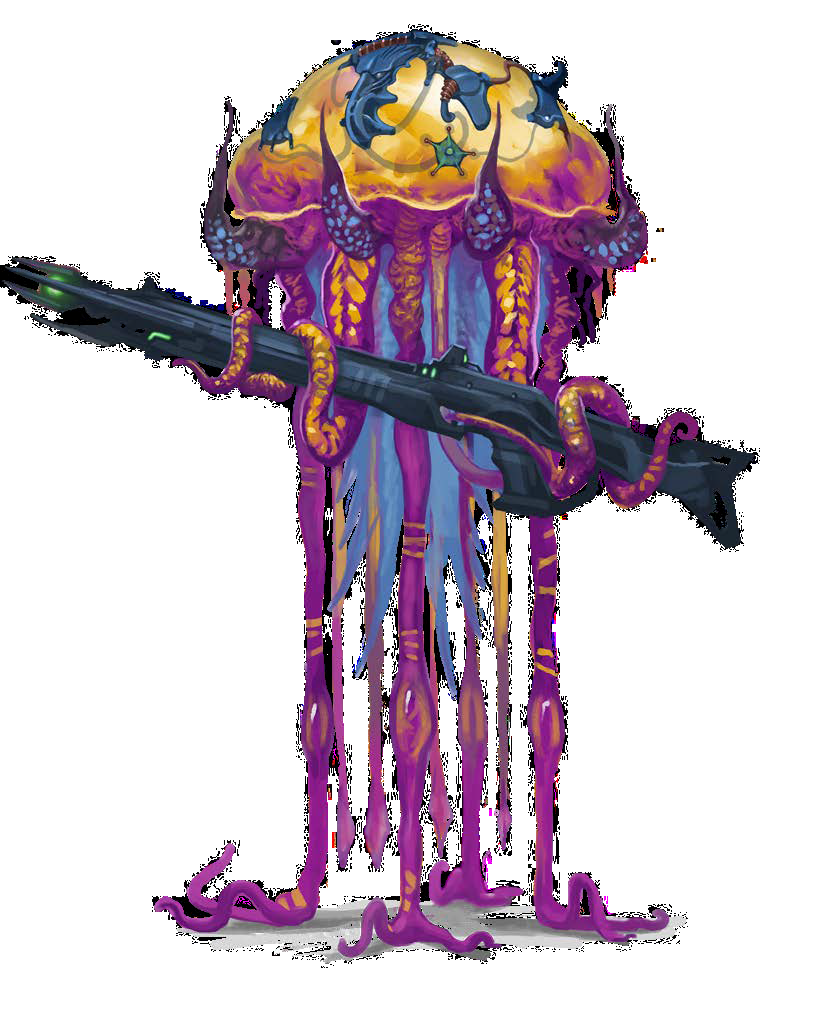Scyphozoan
Scyphozoans evolved from a species of large amphibious sea jellies, which hunted on land and in water along the coastlines of Primoria's temperate zones. A scyphozoan has a soft and translucent body, with several ambulatory tentacles as well as two prehensile tentacles. In water, a scyphozoan swims by expanding and contracting its bell, which propels the creature forward. The bell and tentacles are sensitive to vibrations in the air or water, allowing the scyphozoan to sense nearby creatures even if she can’t see them. A scyphozoan is approximately 7 feet tall and weighs up to 200 pounds. Other species find it difficult to tell male and female scyphozoans apart because the two sexes exhibit few differing characteristics.
Civilization and Culture
Culture and Cultural Heritage
Many scyphozoan cultures and ethnic groups coexist on Primoria, varying from nomadic tribes of plankton herders to advanced city-states obsessed with science and progress. The most advanced and powerful economic and military force on Primoria is the Council States, a commercial and defensive confederation of city-states and tribes. The Council States trade extensively with mycelars and were the motivating force behind the peace treaty between mycelar and scyphozoan nations. The Council States have also gone to great lengths to document the causes that began those great wars, and they have concluded that in most cases, the mycelars were responding to scyphozoan encroachment upon lands long held by generations of mycelars. The history of the wars is never so simple of course, but the Council States believe accepting their part in beginning the generational hostilities is crucial to maintaining the peace that currently helps all the species of Primoria.
Scyphozoans and mycelars have developed “living technology,” genetically manipulated organisms that perform functions similar to mechanical and electronic devices. For example, they send electromagnetic signals through contiguous growths of mycelium for long-distance communication, in the same way other species use cable, and instead of local radio broadcasts, they manipulate pollen to carry messages. Tall, bioluminescent mushrooms act as streetlights, and scyphozoans grow their computers and infospheres from genetically engineered nerve and brain tissue. Less than a century ago, scyphozoans made their first successful interplanetary spaceflight in a living starship. Today, scyphozoans have a few dozen Nautiloidclass ships equipped with Drift engines, and they have made contact with sentient species from the Pact Worlds while exploring new planets.
Most scyphozoan settlements and cities are situated near Eukarya’s west coast, some on land and the rest on the seabed. Houses are often bell shaped and grown rather than built, and many are living creatures in symbiotic relationships with those who dwell within them. Similarly, many scyphozoan vehicles and devices are living organisms, engineered and trained for specific functions. Some of the scyphozoans’ favorite pastimes include raising smooth-haired worms and other domesticated creatures as pets, cultivating algae or mushroom gardens as an art form, and several different types of fast-paced amphibious sports that require both agility and quick thinking.










Comments